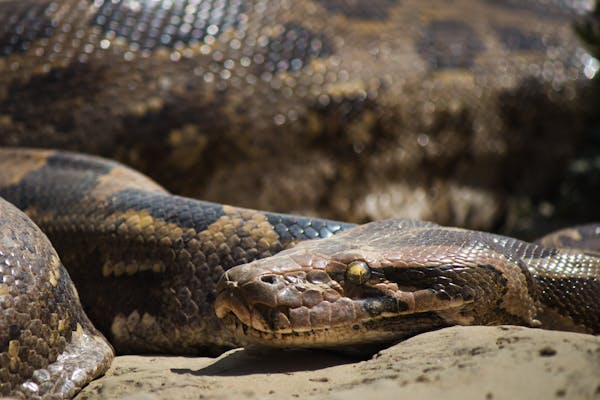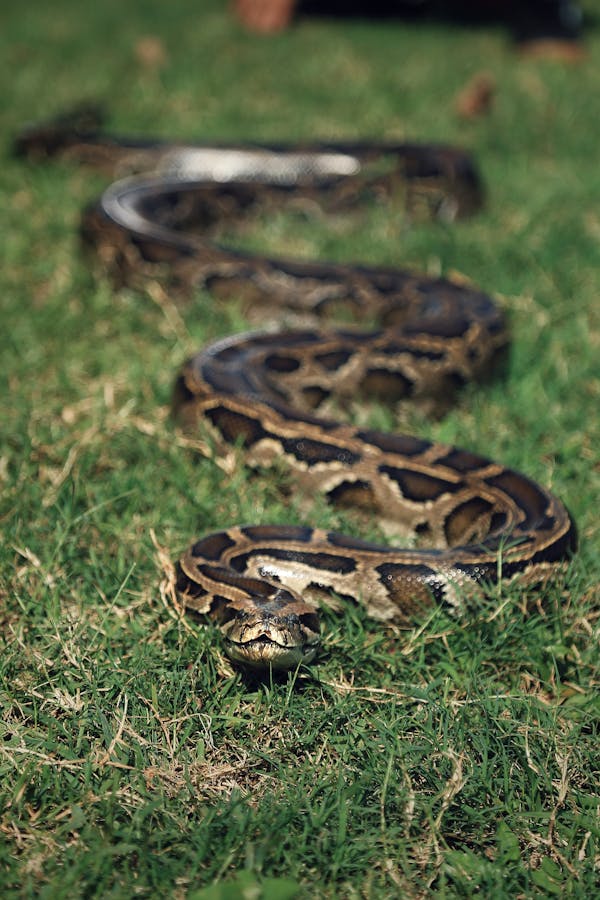
Reticulated Python
Reticulated Python
The reticulated python (Python reticulatus) is a species of python found in Southeast Asia. It is one of the largest snakes in the world, with specimens reaching lengths of over 30 feet and weights of over 300 pounds.
Reticulated Python Classification
Here is the classification of the Reticulated Python:
Kingdom: Animalia
Phylum: Chordata
Class: Reptilia
Order: Squamata
Suborder: Serpentes
Family: Pythonidae
Genus: Python
Species: Python reticulatus
The Reticulated Python belongs to the family Pythonidae, which also includes other large snakes such as the Burmese Python and the African Rock Python. It is classified under the genus Python, which comprises of a number of species of pythons found across different parts of the world.
Reticulated Python Characteristics and Appearance
The Reticulated Python (Python reticulatus) is a species of snake that belongs to the Pythonidae family.
Here are some of its characteristics and appearance:
Size: Reticulated Pythons are one of the largest snake species in the world, and can grow up to 30 feet (9 meters) in length.
Colour: They have a distinctive coloration of dark brown or black scales with a pattern of creamy-yellow lines or stripes that gives them their name "reticulated."
Body: They have a muscular and robust body, with a broad and triangular head that is slightly wider than the neck. The eyes are small and have vertical pupils.

Behavior
Reticulated Pythons (Python reticulatus) are primarily solitary and nocturnal. They are known for their impressive climbing and swimming abilities and are often found near water sources such as rivers, swamps, and ponds.
In the wild, Reticulated Pythons are ambush predators and will lie in wait for their prey to pass by before striking and constricting them. They are capable of consuming large prey, such as deer and pigs, and will often take several weeks to digest a large meal.
In captivity, Reticulated Pythons can become docile with regular handling, but it's important to remember that they are still powerful and potentially dangerous animals. They have a strong feeding response and can mistake hands or fingers for food, so it's important to handle them with care and caution.
It's also worth noting that Reticulated Pythons can be escape artists, and it's essential to ensure that their enclosure is secure and free from any potential escape routes.
Diet:
Reticulated Pythons (Python reticulatus) are carnivorous and feed on a variety of animals, including rodents, birds, reptiles, and even large mammals like deer and pigs. As juveniles, they typically prey on small mammals and birds, and as they grow larger, they will consume larger prey.
Reticulated Pythons are ambush predators and will lie in wait for their prey to pass by before striking and constricting them. They have a highly flexible jaw that allows them to swallow prey much larger than their head. After consuming their meal, they will rest and digest for several days or even weeks, depending on the size of the prey.
In captivity, Reticulated Pythons are typically fed pre-killed rodents or other small mammals. However, it's important to ensure that their diet is appropriate for their size and age, and that they are not overfed, which can lead to obesity and health issues. Additionally, live prey should never be left unattended with a snake, as they can injure or kill the snake in self-defense.
Geography and Distribution
The Reticulated Python is native to Southeast Asia, including countries such as Indonesia, Malaysia, Thailand, and the Philippines. They are found in a wide variety of habitats, including rainforests, grasslands, and swamps.
Their range extends from the Nicobar Islands in the Indian Ocean to the Philippines, Sulawesi, Timor, and the Lesser Sunda Islands. They are also found in the Andaman Islands and have been introduced to some parts of the United States and other countries as a result of the pet trade.
Reticulated Pythons are well-adapted to their environment and can survive in a wide range of conditions. They are excellent swimmers and can also climb trees, making them well-suited to life in the rainforest. However, their populations are threatened by habitat loss, hunting for their skin, and capture for the pet trade. As a result, they are listed as a vulnerable species by the International Union for Conservation of Nature (IUCN).
Habitat and Range
The reticulated python (Python reticulatus) is a species of python found in Southeast Asia, specifically in countries such as Indonesia, Malaysia, Thailand, and the Philippines. They are known to inhabit a variety of habitats, including rainforests, woodlands, grasslands, and riverbanks.
Reticulated pythons are highly adaptable and can thrive in both terrestrial and semi-aquatic environments. They are known to climb trees and swim in water, making them a versatile predator. They are also able to tolerate a wide range of temperatures and can be found in both hot and cooler regions.
Overall, the reticulated python is a highly adaptable species that can be found in a variety of habitats throughout Southeast Asia.sssss

Reproduction and Lifecycle
Reticulated Pythons (Python reticulatus) reach sexual maturity at around 3-5 years of age, depending on their size and health. Mating usually takes place during the dry season, and males will actively seek out females by using their sense of smell to track their pheromones.
After mating, female Reticulated Pythons will lay a clutch of eggs, typically in a nest made of vegetation and debris. The number of eggs can vary but is usually between 20-80, depending on the size and age of the female. The eggs are then left to incubate for around 80-90 days, with the temperature of the nest determining the sex of the hatchlings.
Once the eggs hatch, the young snakes are left to fend for themselves, and they are fully capable of finding their own food and shelter. However, mortality rates are high during this stage, with many young snakes falling prey to predators or environmental factors.
Reticulated Pythons can live for up to 20-25 years in the wild, and up to 30 years in captivity with proper care and nutrition. They are a long-lived species and can continue to grow throughout their life, albeit at a slower rate as they reach maturity.
Environmental Role
As with most predator species, Reticulated Pythons (Python reticulatus) play an essential role in maintaining the balance of their ecosystem. They help control the population of their prey species, which can include rats, mice, birds, and other reptiles. This, in turn, can help prevent overgrazing and defoliation of vegetation, as well as reduce the spread of disease.
Additionally, Reticulated Pythons are important indicators of ecosystem health. As an apex predator, they are at the top of the food chain and can reflect the health of their ecosystem by their population numbers and overall health.
Unfortunately, Reticulated Pythons are also subject to habitat loss and poaching, which can have a negative impact on their ecosystem. The loss of their habitat and decline in their numbers can lead to imbalances in the food chain, affecting both their prey and predator species. Therefore, it is crucial to protect and conserve this species to ensure the health of their ecosystem.
Population and Conservation Status
Reticulated Pythons (Python reticulatus) are listed as a vulnerable species by the International Union for Conservation of Nature (IUCN) due to habitat loss, poaching, and over-collection for the pet trade.
The loss of their natural habitat due to deforestation, agriculture, and urbanization is a significant threat to Reticulated Pythons. They also face a high risk of being killed by humans due to fear or for their skin, which is highly valued in the fashion industry.
Additionally, Reticulated Pythons are popular in the exotic pet trade, which can put pressure on wild populations. While captive breeding programs have helped to reduce the demand for wild-caught specimens, there is still a market for these snakes, and they remain in high demand.
Conservation efforts are focused on protecting the habitat of Reticulated Pythons, enforcing laws against poaching and illegal trade, and raising awareness about the importance of this species in their ecosystem. Many countries where Reticulated Pythons are found have laws protecting them, but enforcement can be difficult, especially in areas with limited resources.
It is important to continue to monitor and protect Reticulated Pythons to ensure their survival and the health of their ecosystems.

Threats and Predators
As apex predators, Reticulated Pythons (Python reticulatus) have few natural predators. However, they are threatened by human activities, habitat loss, and poaching for their skin and meat.
Humans are the biggest threat to Reticulated Pythons. They are often killed out of fear, for their skin, or for their meat. Their natural habitat is also being destroyed at an alarming rate due to deforestation, agriculture, and urbanization.
While they do not have many natural predators, young Reticulated Pythons are vulnerable to a variety of predators such as birds of prey, monitor lizards, and other snakes. The hatchlings and juvenile pythons are at greater risk of predation than adult pythons.
In some cases, larger predators such as crocodiles and large cats may pose a threat to adult Reticulated Pythons, but these incidents are relatively rare.
The biggest threats to Reticulated Pythons are human activities and habitat loss, which have led to declines in their populations and increased vulnerability to other threats. Conservation efforts focused on protecting their habitat and reducing poaching and over-harvesting for the pet trade are critical to their survival.

Reticulated Pythons As An Invasive Species
Reticulated Pythons (Python reticulatus) are not native to many regions outside of Southeast Asia, but they have been introduced to some areas as a result of the pet trade or accidental release. As a result, they have become an invasive species in some parts of the world.
Invasive Reticulated Pythons can have a significant impact on native wildlife, particularly small mammals and birds. They are known to feed on a wide range of prey, including rodents, birds, reptiles, and even small mammals like deer and primates.
Their large size, aggressive behavior, and ability to adapt to a wide range of habitats make them a serious threat to native species. In some areas, Reticulated Pythons have become so abundant that they have caused declines in native wildlife populations, leading to ecosystem imbalances.
Invasive Reticulated Pythons are found in several countries, including the United States, where they have established populations in Florida. The Florida Fish and Wildlife Conservation Commission has implemented measures to control their spread, including hunting and trapping programs.
Overall, the introduction of Reticulated Pythons as an invasive species is a serious concern and underscores the importance of responsible pet ownership and preventing the release of non-native species into the wild.
How dangerous are reticulated pythons?
Reticulated Pythons (Python reticulatus) can be dangerous to humans, particularly if they are not handled properly or if they feel threatened. As one of the largest snakes in the world, they have the ability to inflict serious injury or even death.
Reticulated Pythons have been known to attack and kill humans in rare cases, usually when they feel threatened or cornered. Their large size and strength make them capable of overpowering a human if they choose to do so.
In addition to their physical strength, Reticulated Pythons also have powerful jaws and sharp teeth, which they use to grasp and hold their prey. If a human were to be bitten by a Reticulated Python, it could cause significant injury or even death, particularly if the snake were to constrict its body around the victim.
It is important to note, however, that Reticulated Pythons are generally not aggressive towards humans unless they feel threatened or provoked. As with any wild animal, it is important to exercise caution and respect when in the presence of Reticulated Pythons, and to avoid handling them unless you have the proper training and equipment.
What’s the difference between reticulated pythons and Burmese pythons?
Reticulated Pythons (Python reticulatus) and Burmese Pythons (Python bivittatus) are both large, non-venomous snakes that are often kept as pets. While they share many similarities, there are several key differences between the two species:
-
Geographic Range: Reticulated Pythons are native to Southeast Asia, while Burmese Pythons are native to South and Southeast Asia, including India and Burma.
-
Size: While both species are large, Reticulated Pythons are generally considered to be the longest snake species in the world, with individuals occasionally exceeding 20 feet (6 meters) in length. Burmese Pythons are also large, but they typically reach a maximum length of around 18 feet (5.5 meters).
-
Coloration and Pattern: Both species have distinctive patterns of brown, black, and cream-colored scales, but the patterns are different. Reticulated Pythons have a more intricate pattern of thin, light-colored lines that form a net-like pattern, while Burmese Pythons have a more irregular, blotchy pattern.
-
Behavior: Both species are considered to be relatively docile and easy to handle, but Reticulated Pythons are generally considered to be more active and alert than Burmese Pythons, which are known for their tendency to be more sedentary.
-
Conservation Status: Both species are threatened by habitat loss and over-harvesting for their skins and meat, but Burmese Pythons are considered to be more of a conservation concern due to their declining populations in the wild.
Overall, Reticulated Pythons and Burmese Pythons are both impressive and fascinating snake species, but they have distinct differences in their geographic range, size, coloration, behavior, and conservation status.
Can reticulated pythons be pets?
Reticulated Pythons (Python reticulatus) can be kept as pets, but they are not recommended for inexperienced reptile keepers due to their large size and potentially dangerous behavior. Reticulated Pythons are one of the largest snake species in the world, with individuals occasionally exceeding 20 feet (6 meters) in length, and they require a significant amount of space, specialized care, and handling expertise.
Reticulated Pythons are also known for their potentially aggressive behavior, particularly when they feel threatened or cornered. As with any large snake species, there is always a risk of injury or even death when handling a Reticulated Python, particularly if they are not handled properly or if they become stressed or frightened.
If you are considering keeping a Reticulated Python as a pet, it is important to do your research and consult with experienced reptile keepers or a veterinarian who specializes in reptiles. You will need to provide a large and secure enclosure, appropriate heating and lighting, a varied and balanced diet, and regular veterinary care. Additionally, you will need to have the proper training and equipment to handle the snake safely and to prevent injury to yourself and the snake.
What is the biggest thing eaten by a reticulated python?
Reticulated Pythons (Python reticulatus) are known to have a very wide-ranging and diverse diet, and have been known to prey on a variety of animals, including birds, rodents, primates, pigs, deer, and even other snakes. There have been reports of Reticulated Pythons capturing and consuming large prey, such as crocodiles, but such instances are very rare and have not been well-documented.
The largest prey item on record for a Reticulated Python is likely a human, although such incidents are extremely rare and highly unusual. While attacks on humans are rare, it is important to note that Reticulated Pythons are powerful and potentially dangerous animals, and should be treated with respect and caution at all times.
Here are some interesting facts about Reticulated Pythons:
-
Reticulated Pythons are one of the largest snake species in the world, with individuals occasionally exceeding 20 feet (6 meters) in length.
-
Reticulated Pythons are native to Southeast Asia, and can be found in a variety of habitats, including rainforests, grasslands, and mangrove swamps.
-
Reticulated Pythons are powerful constrictors, and are known to prey on a wide range of animals, including birds, rodents, primates, pigs, deer, and even other snakes.
-
Reticulated Pythons have a distinctive pattern of brown, black, and cream-colored scales, with thin, light-colored lines that form a net-like pattern.
-
Reticulated Pythons have heat-sensing pits on their lower jaw that allow them to detect the body heat of their prey.
-
Reticulated Pythons are considered to be relatively docile and easy to handle, but they can become aggressive and defensive if they feel threatened or cornered.
-
Reticulated Pythons are often kept as pets, but they require a significant amount of space, specialized care, and handling expertise due to their large size and potentially dangerous behavior.
-
Reticulated Pythons are threatened by habitat loss and over-harvesting for their skins and meat, and are listed as a vulnerable species by the International Union for Conservation of Nature (IUCN).
-
Reticulated Pythons are an important cultural symbol in many Southeast Asian cultures, and are often featured in traditional artwork and folklore.
-
Reticulated Pythons have been known to live for up to 20-25 years in captivity with proper care, although their lifespan in the wild is not well-documented.
Blog Upload on - April 13, 2023
Views - 2853

posted By -
Animals Super Store
Related Posts
-
Top 10 Largest & Heaviest Turtles
March 14, 2023 -
King Cobra
April 19, 2023 -
A to Z List of Bird Names With Picture
Sept. 14, 2023 -
Dog Diseases
April 4, 2022 -
 Top 10 Highest Flying Birds
Top 10 Highest Flying Birds
March 1, 2023 -
 DELHI BIRD & ANIMAL HELPLINE
DELHI BIRD & ANIMAL HELPLINE
Aug. 27, 2022 -
Healthy Habits For Animals
Oct. 26, 2023 -
Cow Desiases
April 29, 2022


